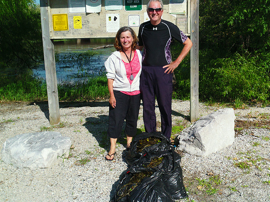In mid-August, LCC members Joan and Pete Smith joined Staff Scientist Mike Winslow to harvest the invasive European frog-bit from a bay east of Dead Creek on Missisquoi Bay. Together they brought in approximately 900 plants!
The Dead Creek population was first discovered by the Lake Champlain Committee and Arrowwood Environmental in 2011 during a vegetation survey of Missisquoi Bay. LCC and Arrowwood have been working to map the lake’s vegetation to provide a baseline against which any future changes due to climate change, new invasive species, or nutrient loading can be documented. LCC is also trying to remove any new populations of invasives we discover through our survey effort. Two years ago, we removed 77 plants from the site which were mixed among floating aquatic vegetation of a State Significant Water Lily Aquatic Community. A return trip in 2012 netted over 300 plants.
The day of this year’s harvest was breezy and sunny, but cool as the team headed out from the Rock River Boat Launch for the two mile paddle to the population. Once there, the trio searched among the native water lilies and water shield for the diminutive frog-bit. Initially it was difficult to spot the invasive amongst the similar looking natives but once team members developed a search image for the rounder smaller frog-bit, the plant seemed to be everywhere. And that's the challenge with frog-bit and many other invasive aquatics. Once they take hold, their populations are hard to control.
European frog-bit is an invasive exotic that resembles a small lilypad. Originally from Switzerland, it was brought to Canada for use in an arboretum in 1932. From there it spread to the United States in the 1980s and now infests lakes and rivers in New York, Vermont, Michigan, Illinois, Ohio and Washington. It grows in shallow, still areas.
Frog-bit has round, smooth, leathery, heart-shaped leaves with stalks about 2 1/2 inches that form a rosette on a short stem. By mid-summer mats of interlocking plants can cover the water surface so thickly that boat props get tangled and can no longer move in the water. The dense mats limit the amount of light that can come into the water so native plants don't grow as well. Frog-bit can also become so thick that it impairs the movement of big fish and diving ducks because there is not enough space between the plants for the fish and ducks to get through.
The invasive plant can readily spread from lake to lake through fragments that have broken off or stuck to a boat. Just a small piece of the plant can start a new colony. For small infestations, physical removal is possible by pulling them out and removing all plant parts and roots from the water. We hope that we can control some of the populations in Missisquoi Bay but annually harvesting them over a multi-year period.
To ensure you don't transport any invasive plants follow these guidelines when boating:
- Inspect your boat, tackle, trailer and other equipment for plant parts.
- Drain all water from the motor, live well and bilge.
- Empty your bait bucket on land far from the water or in the trash.
- Never release bait into a lake, river or stream.
Never move fish or bait from one lake to another.
